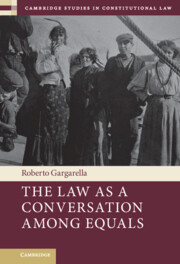Book contents
- The Law As a Conversation among Equals
- Cambridge Studies in Constitutional Law
- The Law As a Conversation among Equals
- Copyright page
- Contents
- Preface
- Acknowledgments
- 1 Constitutionalism and Democracy
- 2 The Law As Conversation among Equals
- 3 “Democratic Dissonance”
- 4 A Constitution Marked by a “Discomfort with Democracy”
- 5 Motivations and Institutions: “If Men Were Angels”
- 6 The Structural Difficulties of Representation
- 7 The Rise and Fall of Popular Control
- 8 The Periodic Vote, or “Electoral Extortion”
- 9 Checks and Balances
- 10 Presidentialism
- 11 Rights
- 12 Social Rights and the “Engine Room”
- 13 Judicial Review
- 14 Constitutional Interpretation
- 15 Constitution Making
- 16 The Birth of Dialogical Constitutionalism
- 17 Why We Care About Dialogue
- 18 “Democratic Erosion”
- 19 The New Deliberative Assemblies
- 20 Conclusion
- Bibliography
- Index
19 - The New Deliberative Assemblies
Published online by Cambridge University Press: 25 April 2022
- The Law As a Conversation among Equals
- Cambridge Studies in Constitutional Law
- The Law As a Conversation among Equals
- Copyright page
- Contents
- Preface
- Acknowledgments
- 1 Constitutionalism and Democracy
- 2 The Law As Conversation among Equals
- 3 “Democratic Dissonance”
- 4 A Constitution Marked by a “Discomfort with Democracy”
- 5 Motivations and Institutions: “If Men Were Angels”
- 6 The Structural Difficulties of Representation
- 7 The Rise and Fall of Popular Control
- 8 The Periodic Vote, or “Electoral Extortion”
- 9 Checks and Balances
- 10 Presidentialism
- 11 Rights
- 12 Social Rights and the “Engine Room”
- 13 Judicial Review
- 14 Constitutional Interpretation
- 15 Constitution Making
- 16 The Birth of Dialogical Constitutionalism
- 17 Why We Care About Dialogue
- 18 “Democratic Erosion”
- 19 The New Deliberative Assemblies
- 20 Conclusion
- Bibliography
- Index
Summary
Iceland has traditionally been recognized as a highly homogeneous, developed, and egalitarian country with a strong welfare state. In the mid-1990s, however, the local authorities became interested in the prevalent economic theories of those times favoring the “free market” over state intervention in the economy through “regulations.” Reforms in the financial market were introduced to liberalize the flow of capital, which ended up making the country’s banks and stock market attractive to investors, at least initially. For almost a decade, the country experienced an unexpected “boom” as foreign funds flooded in, which also left the country at the mercy of capital flux. As early as 2005, Iceland’s economy began showing alarming signs of weakness, including high levels of inflation and a sudden change in the flow of capital: almost overnight, capital began to flow out of the market, and quickly. Now a prisoner to foreign capital and its fluctuations, the economic “shock” was immediately felt: the national currency depreciated by 70 percent; the stock market crashed; and interest rates skyrocketed. By mid-October 2008, the downward spiral seemed uncontainable. Faced with the crisis, the government decided to assert control over the country’s three main private banks and declared the economy in a state of “bankruptcy.”
Keywords
- Type
- Chapter
- Information
- The Law As a Conversation among Equals , pp. 290 - 307Publisher: Cambridge University PressPrint publication year: 2022



